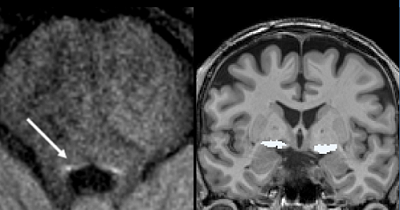The locus coeruleus (LC) and nucleus basalis of Meynert (NBM) are the main nuclei of two important neuromodulatory systems, the noradrenergic and cholinergic systems, respectively. LC is the brain's main source of noradrenaline and plays an essential role in several cerebral functions, including cognition, sleep, emotions and stress responses. NBM is a major cholinergic hub targeting limbic and cortical areas, involved in cortical activation, attention, executive functions and memory processes. These two structures are known to be impaired in the early stages of Alzheimer's disease (AD), but little is known about their involvement in related conditions such as age-related TDP-43 limbic encephalopathy (LATE) and fronto-temporal dementia (FTD) (see box for definitions).
In this work, the researchers assembled a cohort of 72 participants, including 23 with early amnestic AD, 17 with suspected LATE, 17 with FTD and 15 controls, all of whom underwent neuropsychological assessment and 3T brain MRI, and whose diagnosis was based on clinico-biological criteria reinforced by amyloid and tau PET imaging. The authors investigated LC integrity and NBM volume i) in subjects with identical clinical symptoms underpinned by distinct mechanisms (accumulation of tau and amyloid proteins in AD and pathological TDP-43 protein in LATE) and, ii) in patients with another type of TDP-43 or tau pathology (FTD). The researchers also analyzed the relationship between LC/NBM impairment and cognition, as well as medial temporal and cortical atrophy.

3T MRI visualization of LC (left) and NBM (right) in a control subject © Lagarde et al. Alzheimer's Research & Therapy, 2024
Results indicate that i) LC signal and NBM volume are significantly decreased in amnestic AD and LATE patients compared to controls, ii) NBM volume is also lowered in FTD patients (independent of temporal or frontal phenotype) and iii) NBM volume correlates with global cognitive efficiency in AD patients. Strong correlations between NBM volume and that of medial temporal structures, particularly the amygdala, have also been observed in both AD and FTD subjects.
Taken together, these results suggest that the LC and NBM may represent common brain regions of vulnerability to different proteinopathies involved in cognitive neurodegenerative diseases. This study also suggests that targeting the noradrenergic and cholinergic systems appears to be a promising therapeutic strategy in amnestic AD and LATE.
Contact : Julien Lagarde (j.lagarde@ghu-paris.fr)
- Age-related limbic-predominant TDP-43 encephalopathy (LATE) is a neurodegenerative pathology defined by the accumulation in the brain of abnormal TDP-43 protein, particularly in the limbic system, usually in patients over 80 years of age. This recently described disorder is characterized by an amnestic syndrome resembling early AD, without being AD.
- TDP-43: DNA and RNA nuclear-binding protein that regulates transcription and splicing, respectively. Mutations in TDP-43 are implicated in amyotrophic lateral sclerosis and certain fronto-temporal dementias.
- Fronto-temporal dementia (FTD), of which there are several different forms, manifests itself primarily in behavioral disorders (in predominantly frontal forms) and language disorders (in predominantly temporal forms). They can also lead to memory disorders, though these are less frequent than in Alzheimer's disease.
- Proteinopathies refer to a class of diseases in which certain proteins become structurally abnormal and fail to fold into their normal configuration. In their misfolded state, these proteins accumulate and can become toxic.